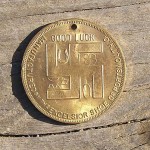Swastika: Good Luck Symbol
Many years ago my Dad was showing me some coins and knick-knacks he had. One item, a token from a 1930-something Boy Scout National Jamboree, caught my attention. On the obverse side of the token was, naturally enough, a picture of a Boy Scout on a horse. On the reverse was a great big swastika. Dad can’t locate the coin now, but it was very similar to the one pictured here, recently posted on ebay:
To take an example of how strong the stigma is and how difficult it seems to be for our culture to deal with it, let’s look at three representations of a classic Luftwaffe fighter, the Messerschmitt Bf-109E. Model airplane kit builders see advertisements for Luftwaffe aircraft model kits with the tail emblem blotted out, morphed into a big black diamond, eliminated or replaced with the black cross of the wing and fuselage insignia. (Hopefully the swastika decal is still in the kit for those who can handle authenticity.)
Even more amazing to me is to see full-size restorations and replicas of Luftwaffe aircraft with no swastika on the tail. Normally, aircraft restorers have an overriding passion for historical accuracy, but the quest for absolute authenticity apparently can’t always compete with the swastika’s stigma in Western culture. The sample Messerschmitt Bf-109E with the swastika shown correctly on the tail was flown in the Yankee Air Museum Airshow 2005. The restoration shown with no Swastika on the tail appears on a .eu (European) Web site. The aversion to even acknowledging the swastika in an historical context is not universal. The swastika continues to be used in its original positive context in Eastern cultures, but its stigmatization in the West prevents us from thinking of the symbol in anything but the “Nazi” context.
Vox’ Take: In some places, “political correctness” has trumped historical truth. That’s a shame. I think it would be very hard for most of us in Western cultures to ever think of the swastika in the positive context it once held, but I don’t think it helps to pretend it never existed. To understand history, we need to always look at the unvarnished truth.
Sources:
[1] Swastika and Cross, Swami B.G. Narasingha
[2] Strafgesetzbuch section 86a, Wikipedia
[3] Swastika, Wikipedia






